|
Englische QBasic- und QuickBASIC-BücherInhalt
EinleitungEs gibt ca. 4 mal mehr englischsprachige als deutschsprachige Bücher über QBasic und QuickBASIC - also bestimmt über 600 Stück. Aus dieser Riesenauswahl habe ich einige sehr gute herausgepickt, die ich hier bespreche. Die allermeisten englischen QB-Bücher sind in einem sehr einfachen und leicht verständlichen Englisch geschrieben und daher auch für solche Programmierer hervorragend geeignet, die nur Grundkenntnisse der englischen Sprache besitzen.Beim Lesen der Bücher fiel mir auf, dass die meisten englischsprachigen Autoren sehr klar und einfach formulieren und den Stoff praxisgerecht mit vielen Beispielen in kleinen Häppchen leicht verdaulich verabreichen. Eine verschraubte, schwer verständliche Gelehrtensprache wie sie in deutschen QB- Büchern gelegentlich anzutreffen ist, findet man kaum. |
Englische QBASIC-Bücher | |
| The Revolutionary Guide to QBASIC | |
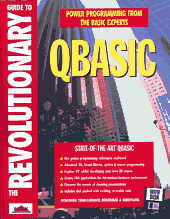
[Bild vergrößern] |
"Power Programming From The BASIC Experts"
von Vladimir Dyakonov (Herausgeber), Victor Munerman und Evgeny Yemelchenkov Wrox Press, 1996, 580 Seiten, mit 3,5" Diskette; 34.95 US $; ca. 36,90 EUR ISBN1-874416-20-6 Kommentar von Thomas Antoni: Dieses gigantisch gute QBasic-Buch für Fortgeschrittene ist wohl weltweit das am meisten gesuchte Gebrauchtbuch über QBasic. Das reine Adrenalin für QBasic-Enthusiasten :-)) Auf jeder Seite erfahren Sie neue aufregende Tricks und Tipps zu QBasic. Das Buch behandelt alle QBasic-Befehle. Als einziges mir bekanntes Buch beschreibt es auch sehr ausführlich die Spiele-, WAV-Sound- und 2D/3D- Grafikprogrammierung inklusive Animationen. Von absoluten Profis in leicht verständlichem Englisch geschrieben. Spieleprogrammierer, die QBasic voll ausreizen wollen, kommen um dieses Buch nicht herum !! Die über 300 auf der Begleitdiskette mitgelieferten Programme sind einfach umwerfend. Content overview on the book cover: The Revolutionary Guide concentrates on the essentials of professional programming and development. So, whether you are a novice programmer wanting to quickly attain the experience of other QBasic gurus, or a professional looking for a comprehensive reference guide to the best power tools in the QBasic world, you will appreciate the in-depth coverage of the essential QBasic features. And these are the highlights of the book:
Review from a 2nd reader: Well, while you can be a beginner and get into this book, I think that you might want to learn on an easier book, because this book does not focus on building upon the simple concepts of QBasic, although, it will brush up on them if you are a beginner. This book is organized quite nice, and covers a lot of material, and is probably the only QBasic book that I have seen that really gets into game programming, which teachs you about making games, concepts in games, what can make games good, how to do stuff... gives much on 2D, 3D, databases, graphics, and more. Highly recommended, I rate this book as intermediate - advanced. Review from a 3rd reader This book attempts to give programmers a new outlook on QBasic, which has long been viewed as a "dead" language. This book is not intended as a quick reference - rather, it is intended for experienced QB programmers who want to harness the power of the compiler in new ways. Included is a chapter on how to make 3D projects like raycaster games. Recommended for experienced programmers looking for advanced DOS audio and graphics programming. Bewertung / Rating: +++ |
| QBasic by Example | |
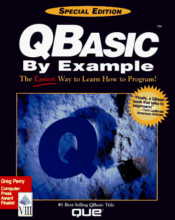
[Bild vergrößern] |
"The Easiest Way to Lean How to Program - Special edition"
von Greg Perry Que Publishing, 1993, 620 Seiten, flexibler Einband; 29.99 US $; 21,19 EUR ISBN 1-56529-439-4 Eine 3,5" Diskette mit allen Programmbeispielen ist für 15.00 US $ getrennt lieferbar Kommentar von Thomas Antoni: Greg Perry ist ein preisgekrönter Autor vieler Computerbücher und ein erfahrener Informatik- Trainer. Laut Aussage das Verlags ist der Bestseller "QBasic by Example" das meistverkaufte QBasic-Buch überhaupt. Dieses anschaulich und leicht verständlich geschriebene Lehrbuch eignet sich sowohl für absolute Programmier- Anfänger als auch für Fortgeschrittene. Es beschreibt fast alle QBasic-Befehle gründlich und in allen Details, und zwar -. wie der Titel schon sagt - immer anhand vieler aussagekräftiger Programm- Beispiele. Insgesamt sind es über 200! Man kann das Buch auch bestens als eine nach Programmierthemen geordnete Befehlsreferenz verwenden. Die Kapitel gehen schön langsam von einfachen zu komplexeren Themen und enden jeweils mit einigen Testfragen und Programmieraufgaben. Die Lösungen stehen hinten im Buch. Einige QBasic- Funktionen werden nicht behandelt wie etwa Binärdateien, ereignisgesteuerte Programmierung mit ON...GOTO, die serielle Schnittstelle und das Zeichnen von Kreisbögen. Das kann man bei diesem wirklich herausragenden Buch aber leicht verschmerzen. Review by a reader: I think this is one of the most well-written QBasic books out there and is one of the few that I continually reference. I used it to learn how to program in QBasic and it was an invaluable tool, filling in all of the gaps left out of other books that I had previously read. Well worth the money, QBasic by Example offers short chapters that really address programming problems and questions you may have. This special edition provides beginning programmers with a helpful format to simplify the learning experience. A best buy - highly recommended! Review by a 2nd reader: Excellent books for beginners — I have experienced a little bit of Qbasic by myself and when I bought this book, I couldn't believe that Qbasic can do even more stuff than I know. It really helps me to understand all about Qbasic and its powerful function. I learned a lot from this book. If you are new to Qbasic, I recommend this excellent book to you. It will train you to become a master in Qbasic. Review by a 3rd reader: Very nice book. This is the first book I read concerning programming and it got me up on my feet. If you have never programmed in anything before, I suggest this book. If you program in C or something, you should have enough sense not to buy it. I wish it would have said more about graphics, but it's supposed to be simple, so I can't really expect some wild effects. I guess I can sum it up in two words, ironically the same as the language: Quick and Basic. Bewertung / Rating: +++ |
| QBasic Programming 101 | |
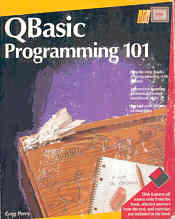
[Bild vergrößern] |
Aus der Reihe "Sams Learning Center"
von Greg Perry Sams Publishing, Inianapolis, 1993, 527 Seiten, flexibler Einband, mit 3,5" Diskette; 29.99 US $ ISBN 0-672-30281-0 Kommentar von Thomas Antoni: Die Zahl "101" steht in den Vorlesungsverzeichnissen vieler US-amerikanischer Colleges für absolute Einsteigerkurse, also Vorlesungen für "Newbies" und "Rookies". So ist auch dieses Buch ein Lehrbuch für Neulinge in QBasic und im Programmieren. Greg Perry ist Professor für Computertechnik und ein berühmter Bestseller-Autor. Er aktiviert den Leser durch viele Programmbeispiele, Übungsaufgaben, Kontrollfragen, Bilder und Icons zum intensiven Mitmachen. Das Buch ist sehr kurzweilig zu lesen und eignet sich gut als Lehrbuch für den IT-Unterricht an Schulen. Der Autor erklärt den Stoff äußerst verständlich, gründlich und in kleinen Schritten, denen man bequem folgen kann. Aber statt mit vielen Leerseiten und breiten Rändern "Seiten zu schinden" hätte Greg Perry lieber die weggelassenen QBasic-Funktionen erklären können wie etwa die Parameterübergabe an SUB- Prozeduren, binäre Dateien, dynamische Felder, das Zeichnen von Ellipsen, die Bearbeitung des Joysticks und der seriellen Schnittstelle, die Bildung von Wartezeiten, den SHELL- Befehl und globale Variablen mit COMMON/DIM SHARED. Auch die Debugging- Funktionen hätte man ausführlicher erklären können. Einem Anfänger-Lehrbuch kann man diese Lücken aber verzeihen. Unverständlich ist dagegen, dass der Leser erst auf Seite 73 mit dem ersten kleinen Beispielprogramm konfrontiert wird. Die Begleitdiskette enthält alle Beispielprogramme (über 100) und einige zusätzliche Goodies. Review by Thomas Antoni: This beginner's textbook of QBasic has been written by Greg Perry who is an IT lecturer and a well-known bestseller author. He motivates the reader's cooperation by means of many example programs, exercises and check-back questions. The book is well-suited as a textbook for IT lessons. It is written in a clear, vivid and comprehensible style. The author explains all subjects with full details and in small easy-to-follow steps. But some important QBasic topics are missing, i.e. parameter passing to SUB-procedures, binary files, dynamic arrays, drawing ellipses, using the joystick and the serial port, generating delays, the SHELL statement and global variables with COMMON/ DIM SHARED. The debugging functions are just touched. All this could be excused with a beginner's book. However, the reader must wait until page 73 until learning the first example programm; this appears to me as an unexcusable flaw. The companion disk provides all 100+ example programs and some additional goodies. Short decription on the cover page: Step-by-step guide to programming with QBasic • Interactive Learning promoted through workbook style • Packed with dozens of examples • Disk features all source code from the book, selected answers from the text, and exercises not included in the book Bewertung / Rating: +++ |
| Crash Course in QBasic | |
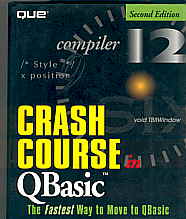
[Bild vergrößern] |
"The Easiest Way to Move to QBasic"
von Greg Perry und Stephen Potts Que Corporation, Indianapolis, Second Edition, 1994, 272 Seiten, flexibler Einband; 19.99 US $; 17,20 EUR ISBN 1-56529-939-6 Kommentar von Thomas Antoni: Dieser Band ist quasi die 10 $ preiswertere Sparversion des oben besprochenen Bestsellers "QBasic by Example". Eine Begleitdiskette ist nicht lieferbar. Das Buch hält was es verspricht: "Sturzhelm auf und hinein in die aufregende Welt von QBasic". Ohne theoretischen Ballast erhält der Einsteiger eine gründliche Einführung in die wichtigsten Funktionen von QBasic. Dabei würzen die Autoren den leicht verständlich 'rübergebrachten Stoff mit einer Unmenge aussagekräftiger Beispiele - nach dem Prinzip "Ein Beispiel sagt mehr als 1000 Worte". Nicht behandelt werden Dinge wie Binäre Dateien, das Zeichnen von Ellipsen, und die Ansteuerung der seriellen Schnittstelle.Das kann man einem Anfänger-Lehrbuch gerne verzeihen. Weniger verzeilich ist, dass die Anzeige von Grafiken und die Sound-Erzeugung nur kurz gestreift werden und der Erzeugung von Zufallszahlen ganz fehlt. Leider schindet der Verlag die 272 Seiten nur mit vielen Leerseiten und extrem breiten Seitenrändern heraus. Der Buchinhalt hätte auch glatt auf 200 Seiten gepasst. So verfehlt das ansonsten sehr gute Buch eine "+++" Wertung ganz knapp. Short Description by the publisher: For fast and easy access to QBasic programming, this is the best tutorial and reference. It puts readers on a fast track to learning QBasic fundamentals, with no-frills instructions and succinct examples that get beginning programmers productive instantly. Syntax-at-a-Glance boxes highlight each statement's syntax and parameters. Covers operators, variables, input and output, data structures, modular programming, sound and graphics, and more. The fastest way to learn QBasic from scratch. Covers Version 1.x. Review from a reader: Even if you've never programmed before, "Crash Course in Q Basic" offers a no- frills quick introduction into this easy programming language. Take it one step at a time and soon you'll be writing simple programs. By the end of the book you'll have a good knowledge of the language and be able to write moderately complex programs. I teach basic programming to beginners and recommend this book as an excellent reference. Review from another reader: A very good book for beginning programmers. This being my first programming book after learning GW-BASIC, I found this book to be very well written considering the size of the book. If you just don't have much time to spend learning QBasic, this book takes you on a Crash Course (surprise) through the fundamentals of the language with plenty of examples demonstrating the topic effectively. I STRONGLY recommend this book if you want to learn QBASIC. Bewertung / Rating: ++ |
| Teach Yourself QBasic in 21 Days | |
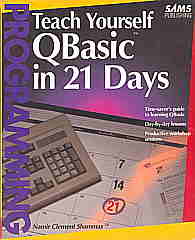
[Bild vergrößern] |
"Time-saver's guide to learning QBasic — Day-by-day lessons —
Productive workshop sessions"
von Namir Clement Shammas Sams Publishing, Carmel, 1993, 831 Seiten; 24.95 US$ ISBN 1-672-30324-8 3,4" oder 5,25" Begleitdiskette mit allen Beispielprogrammen für 10.- US$ beim Autor getrennt lieferbar. Kommentar von Thomas Antoni: Namir Clement Shammas ist professioneller Software-Entwickler und Autor vieler Zeitschriftenartikel und Bücher. Im vorliegenden Buch führt er den Leser in 3 Wochen vom absoluten Programmier-Anfänger zum Profi in der QBasic- Programmierung. Pro Tag gibt es eine gut aufgebaute Lektion, die man in ca 1,5 Stunden bequem durcharbeiten kann und die durch einen kleinen Workshop mit Quizfragen und Übungsaufgaben abgeschlossen wird. Das Ganze ist didaktisch hervorragend aufgebaut. Bereits in der ersten Lektion macht der Autor dem Leser Geschmack auf QBasic, indem er bereits hier die ersten kleinen Beispielprogramme bringt, ohne gleich großartig in die Theorie einzusteigen. Das Buch ist gewürzt mit vielen Profi-Tipps in "Do/Don't"-Boxen. Insgesamt ein super Buch! Schade, dass es in deutscher Sprache nichts Vergleichbares gibt. Es wird fast der ganze QBasic- Sprachumfang gründlich und mit unzähligen, gut kommentierten Beispielen behandelt. Einige kleine Lücken sind mir jedoch aufgefallen: Es fehlen das INPUT Statement (nur die INPUT$()-Funktion ist erklärt), die Erzeugung von Wartezeiten mit TIMER und die Befehle MKDIR und RMDIR zum Anlegen und Löschen von Verzeichnissen. Auch die Bearbeitung des Joysticks und der seriellen Schnittstelle hat der Autor ausgeklammert. Diese Lücken lassen sich bei einem Einsteigerkurs aber leicht verschmerzen und ändern nichts an der guten Bewertungsnote. Pruduct description by the publisher: QBasic in a logical, easy-to-follow format! This excellent tutorial will have readers performing advanced programming techniques such as drawing graphics and adding music in just a few short weeks. Features Q&A sections to help answer common questions users have about learning QBasic. Includes a comprehensive glossary that provides definitions for key programming terms Review by a reader: Great step up book to the programming world of Q-Basic. This book, is great for even the most inexperienced programmers. Even with my background of other "basic" programming languages, this book put my knowledge over the top. My group ordered this book, for an upcoming contest, and from the information, we will have the advantage. I recommend this book to beginners and experts alike. This one is a must! Review by another reader I could not put it down, it is a masterpiece of computer knowledge. I loved it so much, I actually finished in 20 days!! Bewertung / Rating: +++ |
| QBasic Programming for Dummies | |
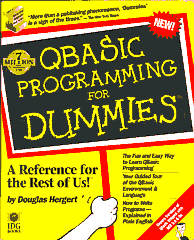
[Bild vergrößern] |
"A Reference for the Rest of Us!"
von Douglas Hergert IDG Books Worldwide, Foster City, California, 1994, 400 Seiten; 19.95 US$ ISBN 1-56884-093-4 3,4" oder 5,25" Begleitdiskette mit allen Beispielprogrammen für 15.- US$ getrennt lieferbar. Kommentar von Thomas Antoni: Dieses Buch soll den Einstieg in QBasic kinderleicht machen. Diesen Anspruch erfüllt es aber höchst unzureichend. Im Rahmen einer weitschweifigen Einführung in die Bedienungsoberfläche von QBasic wird der Leser z.B. gleich am Anfang mit einem extrem komplexen, 4 Seiten langen Beispielprogramm konfrontiert, das 5 Prozeduren enthält! Viel günstiger für den Einstieg wäre ein einfaches "Hello World"-Programm gewesen. Das ganze Buch wimmelt nur so von länglichen und hochkomplizierten Beispielprogrammen. Der Autor geht nicht Schritt für Schritt vor: Die Beispielprogramme enthalten oft Funktionen, die erst viel später im Buch erläutert werden. Gut finde ich dagegen die vielen Tipps für einen guten und strukturierten Programmierstil sowie die häufigen Hinweise auf die hervorragende QBasic-Online-Hilfe. Das Buch erläutert viele wichtige Funktionen von QBasic, erlaubt sich aber Riesenlücken. Dass die Bearbeitung binärer Dateien und die Ansteuerung der seriellen und parallelen Schnittstelle fehlt, möge man einem "Dummy"-Buch noch verzeihen. Leider fehlen aber auch viele essenzielle und gerade für junge Einsteiger hochinteressante Funktionen wie etwa die Ansteuerung des PC-Speakers, farbiger Text, Joystick, Zufallszahlen, Grafikerzeugung mit PAINT und DRAW, Aufruf von DOS-Befehlen mit SHELL, die Bildung von Wartezeiten mit TIMER und Winkelfunktionen. Statt mit vielen Leerblättern und faden Comics Seiten zu schinden hätte der Autor lieber auf solche Dinge eingehen sollen. Mir persönlich ist unverständlich, wie dieses Machwerk zu einem der meistverkauften QBasic-Bücher werden konnte. Pruduct Description by the publisher: Another in the popular "For Dummies" series, this book is a fast and friendly reference to QBasic, the most popular language for novices learning to program, QBasic for Dummies leads readers, in a sequence of easy exercises, through all the beginning steps - how to start QBasic, type the lines of a program, correct mistakes in the code, and get your own homemade computer program up and running. Recommended for beginner programmers with little or no programming/computer experience. ... QBasic Programming For Dummies steers clear of highfalutin technical terms and programming jargon. Instead, you build a programming foundation in QBasic step- by-step with this book's clear, easy- to- understand language. From fundamental program organization through advanced topics on data types and arrays, graphics, and debugging, QBasic Programming For Dummies is an invaluable guide to mastering the QBasic programming language. Review by a reader: This book helped me learn everything I needed to know about Qbasic. The examples were very helpful. I recommend this book to anyone interested in Qbasic. Review by a 2nd reader: This book goes through QBasic very thoroughly but does not go very far into the language. If you have no knowledge of QBasic what-so-ever, then this book probably isn't for you. I learned quite a bit from this book myself, but I only read it once since the concepts are so simple. There are probably better beginner books which go into more detail, but I can't name any. I would probably recommend those more than this, however. Review by a 3rd reader: I've owned this book for awhile, and don't find it any helpful. First, the author starts with advanced topics, then uses examples that take much longer than they need to be just to illustrate a point. I think it takes about 5 chapters before the PRINT function, one of the simplest and best to experiment with, is learned. This book is not for beginners,.... Otherwise... I can see why one of the other reviewers could not grasp it. I couldn't, even with some experience. But now I program in C++, and QBASIC is MUCH weaker. Review by a 4th reader: This book was not what I was looking for. I am a beginner with no background in computer programming. I did the exercises and read and reread everything in the first 5 chapters of this book and I just wasn't able to grasp the concept of what I was trying to do. I was doing all the programs, but I didn't quite understand the basic elements of QBASIC. For me the book need to start on a more fundamental level. Once I get the fundmentals I plan on going back to "QBASIC for Dummies" and finish the book. Bewertung / Rating: + |
| Using QBasic | |
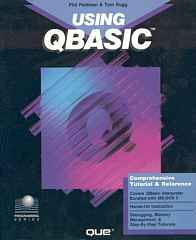
[Bild vergrößern] |
"Comprehensive Tutorial & Reference"
von Phil Feldmann & Tom Rugg Que Publishing, 1991, Softcover, 842 Seiten; 24.05 US$ ISBN 0-88022-713-3 Kommentar von Thomas Antoni: Dieses Buch ist ein Traum! Der erste Teil gibt Programmier-Newbees eine fundierte und didaktisch hervorragend aufgebaute Einführung in QBasic. Phil Feldmann und Tom Rugg bringen ihr Potential als erfahrene Informatik-Autoren voll zur Geltung. Sie erklären dem Leser Schritt für Schritt mit vielen erfrischend kurzen Programmbeispielen die QBasic-Entwicklungsumgebung und die grundlegenden Befehle. So kommt der Leser zu schnellen Erfolgserlebnissen, und er wird das Buch so schnell nicht aus der Hand legen. Im zweiten Teil kommen auch fortgeschrittene Programmierer auf ihre Kosten und erhalten eine fundierte Übersicht über den gesamten Sprachumfang von QBasic. Auch Spezialthemen, um die sich viele andere Bücher herumdrücken, werden in allen Details behandelt, wie etwa
Review by Thomas Antoni: In its first part, this fantastic book gives a well-based and easy-to- learn introduction to QBasic. This part is ideally suited for programming newbees. Phil Feldmann and Tom Rugg fully utilize their skills as experienced IT authors. They proceed in a step-by-step manner and with a wealth of tiny little example programs. Thus, the reader ist well motivated to learn all about the QBasic development environment and the most important statements. The second part is for advanced programmers and gives a comprehensive overview of all QBasic language elements. Some very special topics are explained as well which are not dealt with in many other books, e.g.
Product description by the publisher: This is a tutorial and reference for those new to QBasic. Step-by-step tutorials introduce the essential concepts of QBasic. These are supplemented by more practical instruction and programming examples. The book includes a keyword reference. Bewertung / Rating: +++ |
| Common-Sense Basic | |
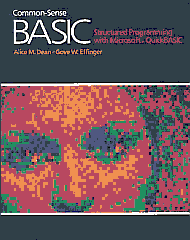
[Bild vergrößern] |
"Structured Programming with Microsoft QuickBASIC"
von Alice M. Dean und Gove W. Effinger Verlag Thomson Learning, März 1991, Taschenbuch im Großformat, 415 Seiten ISBN 0155122975 Kommentar von Thomas Antoni: Dieses hervorragende "Mitmachbuch" ist als Lehrbuch für einen halbjährigen Informatik-Kurs in QuickBASIC 4.5 oder 4.0 konzipiert. Nach einer Einführung in die Entwicklungsumgebung und die grundlegenden Befehle machen die Autoren den Leser mit den wichtigsten Programmierthemen bekannt. Jedes Kapitel enthält eine reichhaltige Auswahl gut kommentierter Bespielprogramme. Mit vielen Kontrollfragen und Übungsaufgaben tritt das Buch in einen intensiven Kontakt mit dem Leser und hält ihn bei der Stange. Die Antworten zu den Kontrollfragen und die Lösungen der Übungsaufgaben findet man hinten im Buch. Den Autoren gelingt es vorzüglich, auch komplizierte Zusammenhänge leicht verständlich zu erklären. Sie legen großen Wert auf einen gut strukturierten, modularen Programmierstil. Die Beispielprogramme machen Spaß. So gibt es z.B. Menüs, Balkendiagramme und eine im Textmodus "gemalte" farbige US-Flagge. Ich habe nur wenige Kritikpunkte anzubringen. So findet man bei den Wertzuweisungen durchgängig den antiquitierten LET-Befehl (also "LET a = b" statt "a = b"). Auch hat das Buch einige Lücken: Nicht behandelt werden die Befehle BEEP, DRAW, Grafik-GET/PUT, SHELL, die modulare Programmierung mit Bibliotheken und $INCLUDE-Dateien, die Datenausgabe auf Drucker und serielle Schnittstellen, die Joystick-Abfrage und binäre Dateien. Andererseits kann man von einem Einsteigerkurs natürlich nicht verlangen, dass er den gesamten Sprachumfang abdeckt. Alles in Allem: Ein rundum gelungenes, praxisorientiertes Buch. Warum gibt es dergleichen eigentlich so selten im deutschen Sprachraum? Bewertung / Rating: +++ |
| Qbasic for Students | |
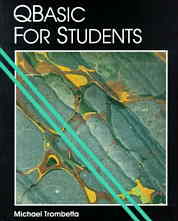
[Bild vergrößern] |
Von Michael Trombetta
Verlag: McGraw-Hill Education, 1993,Taschenbuch, 736 Seiten ISBN 0070652619 Synopsis by the Publisher: Designed for a first course in programming, this text assumes a problem-solving approach to QBASIC programming concepts. Each chapter begins with a problem statement; concepts for solving the problem follow. A structured, seven-step procedure is used throughout the text and provides a framework for solving problems. The seven steps include: variable names; algorithm; hand-calculated answer; QBASIC program; entering the program; executing the program; comparing hand-calculated answer. Each chapter includes objectives, extensive screen displays, example programs with explanations and a summary of new QBASIC statements. Each chapter ends with a chapter review, summary, key terms, a self- check and a programming assignment. Because QBASIC is part of the Microsoft DOS 5.0 and 6.0 operating systems, students will not need to purchase software to use this text. There is also an instructor's manual set which includes an instructor's solutions disk, 3.5" IBM. The Author on his Book: The book teaches you the fundamentals you need to program. I have more than 20 years teaching programming to communitiy college students, so I know the pitfalls and difficulties. This book is the best introduction to programming, and will give you the foundation you need to move on to Visual Basic and /or C+ Review by a Reader: This is a must for students going into AP Computer Programming. As a junior in high school, I had to take a placement exam as a prerequisite for AP Computer Programming. This book helped teach me the basics to the advanced portions of QBasic, and thus helped me a great deal. I highly recommend this easy to learn QBasic book. |
| QBASIC Fundamentals and Style | |
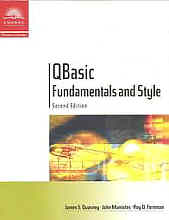
[Bild vergrößern] |
Von John Repede
Verlag: Course Technology Inc, 2. Auflage, 1996, Taschenbuch, 308 Seiten ISBN 0789500213 Review by a reader: Very good book for individuals looking to explore the basics of programming. Covers structured programming techniques and other basic fundamentals of programming. Perfect for students who want to discover if programming is an industry they would like to enter. Review by a 2nd reader: I just finished a class in QBASIC using this book and it was very easy to follow. It also has many great problems with which to quiz yourself and includes many great programming examples which will be similar to actual programs you will write in the workplace. |
| A Brief Course in QBasic With an Introduction to Visual Basic | |
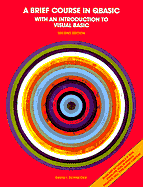
|
Von David I. Schneider
Verlag Macmillan, USA, 1994, Taschenbuch, 363 Seiten, mit Begleitdiskette ISBN 0024077410 Synopsis by the Publisher: For any course in which programming is one of several topics taught, Schneider's A Brief Course in QBasic, Second Edition, is the ideal programming text. In roughly 300 pages, A Brief Course in QBasic, Second Edition, teaches students all aspects of QBasic and provides a foundation in structured programming, with emphasis on problem-solving techniques. It covers the fundamentals of computer programming, such as input, decision structures, and loop structures. The book is designed for use with the IBM-PC and its compatibles. |
| Qbasic Using Subprograms | |
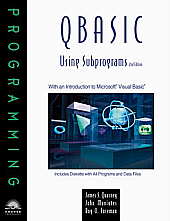
[Bild vergrößern] |
"With an Introduction to Microsoft Visual Basic"
von James S. Quasney, John Maniotes und Roy O. Foreman Verlag: Course Technology Inc, 2. Auflage 1997, Taschenbuch, 592 Seiten Die beiliegende Diskette enthält alle Beispielprogramme und Daten-Dateien. ISBN 0760050996 |
| Programming in QBasic for Engineering Technology | |
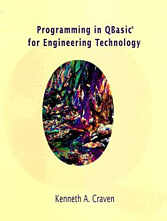
[Bild vergrößern] Inhaltsübersicht |
Von Kenneth A.Craven
Verlag Pearson US Imports & PHIPEs, Taschenbuch, 451 Seiten ISBN 0136227481 Kommentar von Thomas Antoni: Ich besitze dieses Buch nicht und habe es nicht gelesen. Daher kann ich es auch nicht bewerten. Der Inhaltsübersicht des Autors entnehme ich, dass es sich mehr um ein normales Einsteigerbuch für Programmier- Anfänger handelt und weniger um ein spezielles Buch für Ingenieure. Nur die beiden Kapitel über die Analyse großer Datenmengen sowie über die mathematischen Funktionen machen das Buch eventuell für Ingenieur-Studenten besonders interessant. ... zur Inhaltsübersicht des Autors Product description by the publisher: The book is suitable for introductory undergraduate courses in programming for engineering technology students. It is challenging - but not overwhelmingly so - this focused text uses BASIC to teach the fundamentals of computer programming. It clearly explains fundamental data types, data structures, control structures, and programming techniques. It requires no prior experience with computers. It is written from an engineering point of view, but it requires no knowledge of engineering principles. The book
|
| Qbasic Games & More! | |
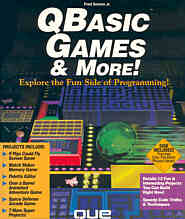
[Bild vergrößern] [zur ausführlichen Inhalts- übersicht des Buches] |
Von Fred Sexton Jr.
Que-Verlag, Mai 1993, Taschenbuch, 320 Seiten, mit 3,25"-Begleitdiskette ISBN 1-56529-231-6 Kommentar von Thomas Antoni: Dieses Buch vermittelt dem Leser, dass Pogrammieren einen Riesenspaß bringen kann. Es widmet sich der Entwicklung von Spielen und atemberaubenden Grafik-Effekten. Es werden 12 Programmprojekte angeboten und ausführlich beschrieben. Darunter
Eine ausführliche Inhaltsangabe des Buches steht unter "QBasic Games & More!" Content Overview zur Verfügung. Synopsis by the Publisher: For programmers who want to use QBasic for more complex applications, this book shows how to get fun, high-level results. It provides step-by-step lessons and program samples, and enables readers to tinker with the provided code and build their own additions into entertaining, viable programs. A detailed content overview of the book is available on "QBasic Games & More!" Content Overview. Bewertung / Rating: +++ |
Englische QuickBASIC-Bücher | |
| The Waite Group's Microsoft QuickBASIC Bible | |
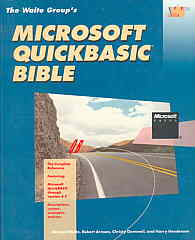
[Bild vergrößern] |
"The Complete Reference — Featuring: Microsoft QuickBASIC through version 4.5 —
Descriptions, syntax, examples, and tips"
von Mitchell Waite, Robert Arnson, Christy Gemmell, and Harry Henderson Microsoft Press, Redmond / The Waite Group, 1990, 963 Seiten, flexibler Einband; 27.95 US$ ISBN 1-55615-262-0 3,5" Diskette mit allen (über 200) Programmbeispielen für 18.95 US$ getrennt lieferbar Kommentar von Thomas Antoni: Dieser fette Wälzer ist einzigartig. Die "QuickBASIC-Bibel" ist kein Lehrbuch, sondern eine gigantische Befehlsreferenz. Das fantastische Werk beschreibt sämtliche QuickBASIC-Befehle in allen Details. Jede auch noch so kleine Facette der einzelnen Befehle wird ausführlich von allen Seiten beleuchtet. Für 22 Programmieraufgaben wie etwa mathematische Funktionen, Grafik und Debugging gibt es ein eigenes Kapitel. Am Anfang jedes Kapitels steht ein Tutorial, das in das Thema einführt; dann folgt jeweils eine ausführliche Referenz aller zu dem Thema gehörenden Befehle mit vielen aussagekräftigen und gut kommentierten Beispielprogrammen. Zu jedem Befehl ist eine hochinteressante Kompatibilitätsliste angegeben, aus der die Kompatibilität zwischen den verschiedenen BASIC- Programmiersprachen QB 2, QB 3, QB 4, QB 4.5, MS BASIC 7, ANSI-BASIC, PowerBASIC, GW-BASIC und MacQB (QuickBASIC für Apple Macintosh) angegeben ist. Im Textteil werden die Unterschiede zwischen den einzelnen Sprachen bei jedem Befehl ausführlich diskutiert. Eine derart ausführliche vergleichende Befehlsbeschreibung habe ich noch nirgends gesehen. Nicht behandelt wird die QuickBASIC-Entwicklungsumgebung. Auch der Umgang mit Bibliotheken und Modulen wird nur kurz gestreift. Dafür gibt es eine äußerst nützliche Übersicht über diverse QuickBASIC-Toolboxen, die von den Drittherstellern Crescent, MicroHelp und Hammerly angeboten werden und quasi den Sprachumfang von QuickBASIC entscheidend erweitern. Excerpt from the foreword by Tom Button, Microsoft BASIC Program Manager They (The Waite Group) have written the defenite programmer's reference guide to QuickBASIC. ...the most comprehensive reference book on QuickBASIC I've ever seen. Synopsis by the publisher This is the definitive reference, the cornerstone - indeed, the "bible" - on Microsoft QuickBASIC™. It's a gold mine of comprehensive, up-to-date information, superb program examples, and expert advice. Its clear organization offers immediate access to
Bewertung / Rating: +++ |
| QuickBASIC: The Complete Reference | |
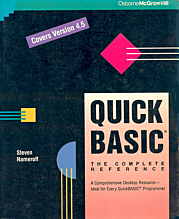
[Bild vergrößern] |
"A Comprehensive Desktop resource — Ideal for Every QuickBASIC Programmer —
Covers Version 4.5"
von Steven Nameroff Osborne McGraw-Hill Verlag, 1989, 593 Seiten, flexibler Einband; 26.95 US$ ISBN 0-07-881362-x 5,25" Diskette mit allen Programmbeispielen für 19.95 US$ getrennt lieferbar Kommentar von Thomas Antoni: "QuickBASIC: The Complete Reference" ist gleichzeitig ein Lehrbuch und ein Nachschlagewerk für die QuickBASIC- Versionen 4.0 und 4.5. Von dem dickleibigen Werk profitieren sowohl Einsteiger als auch fortgeschrittene BASIC- Programmierer. Steve Nameroff ist ein absoluter Programmierprofi und Chefentwickler bei der U.S. Air Force. Er hat die Gabe, auch komplexe Zusammenhänge in einem leicht verständlichen Englisch anschaulich zu beschreiben. Diese QuickBASIC Enzyklopädie gliedert sich in 4 Teile:
|
| Programming in QuickBASIC | |
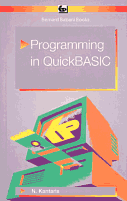
[Bild vergrößern] |
Von Noel Kantaris
Bernard Babanis (publishing) LTD, erweiterte Auflage 1996, Taschenbuch, 168 Seiten; 5.99 £ ; 8,41 US $ ; ca. 13,- EUR ISBN 0-85934-229-8 5,25" Diskette mit allen 78 Beispielprogrammen für 3.50 £ ca. 5,- EUR getrennt lieferbar bei www.philoliver.com/discoffer.htm Kommentar von Thomas Antoni: Dieses preiswerte Büchlein ist sehr gut und in einem leicht verständlichen Englisch geschrieben. Ich habe es auf einem England-Urlaub gekauft, mit Genuss vor meinem Notebook sitzend durchgearbeitet und in wenigen Tagen verschlungen. Das Werk besteht aus drei Teilen:
Review by Thomas Antoni: This favorably-priced book is written in clear an easy understandable English and consists of the following three parts:
Bewertung / Rating: +++ |
| PC Magazine BASIC Techniques and Utilities | |
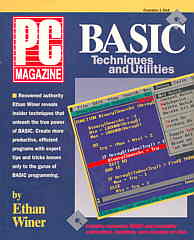
[Bild vergrößern] |
Von Ethan Winer
Ziff-Davis Press, Emeryville, California, USA, 1991, Hardcover, 565 Seiten, mit 5,25" Diskette ISBN 1-56276-008-4 / 1562760084 Kommentar von Thomas Antoni : Riesiges professionelles QuickBASIC-Buch des berühmten, weltweit anerkannten QuickBASIC-Gurus Ethan Winer. Nichts für Einsteiger, sondern eher etwas für Profis und Hardcore-Programmierer, die unter die Haube von QuickBASIC schauen und möglichst viel über die Systemprogrammierung lernen wollen. Schwerpunkt- Themen dieses fetten Wälzers sind
Dieses Buch steht übrigens auf www.QBasic.de als elektronisches Buch im PDF-Format zum kostenlosen Download zur Verfügung - inklusive dem kompletten Inhalt der Begleitdiskette ... zum E-Book "PC Magazine's BASIC Techniques and Utilities". Unter dem Titel "BASIC Profitechniken und Tools" gibt es auch eine deutsche Übersetzung des Buches. Eine Rezension dieser deutschen Version finden Sie in der Rubrik QuickBASIC-Bücher. Review by Thomas Antoni : The woldwide known and famous QuickBASIC guru Ethan Winer wrote this QuickBASIC book for professionals. This one is not for QB rookies. It has been made for pros and hardcore programmers who want to look "under the hood" of QuickBASIC and learn as much as possible about system programming. Main subjects of this heavy tome are
Review by Book News, Inc. : Winer, a contributing editor of PC magazine and BasicPro magazine, presents power programming using Microsoft compiled BASIC to people who already understand the fundamentals of BASIC programming, but want to squeeze as much performance as possible from the BASIC compiler. Short Description from Ethan Winer's Website www.ethanwiner.com : Ethan Winer's best-selling book PC Magazine BASIC Techniques and Utilities is now out of print, but it's available here. The download package contains the complete text of this popular book, along with source files for all of the subroutines and example programs that were included in the original printed edition. Thomas Antoni has converted my entire book into PDF format, and made it available on his website www.QBasic.de as E-Book "PC Magazine's BASIC Techniques and Utilities". This is the version I now recommend. It also integrates a full image of the book's companion disk. Review by Karl E.Peterson : In my opinion, Ethan was the original Basic Guru. It was his willingness to share that served as my inspiration for helping out as I do now in online communities. For example, his best-selling book PC Magazine BASIC Techniques and Utilities is now out of print, but it's available at his web site for downloading. Although not as much a part of the Basic community now, as previously, his contributions can never be understated. Swing by his site, and take a listen (do not miss Disco Rainbow!) to some of the music he's composed! Review by a reader : PC Magazine's Basic Techniques and Utilities Or Ethan Winer's book. For intermediate programmers, not a "learn QB" book. Understand what happens "under the hood". As it was written in 1989, not a word about graphics!!. Bewertung / Rating: +++ |
| QuickBasic and QBASIC Using Modular Structure with Visual Basic | |
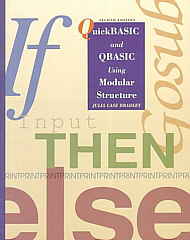
[Bild vergrößern] |
"Alternate Edition with Visual Basic"
von Julia Case Bradley (Mt. San Antonio College) Verlag Irwin/ McGraw-Hill, 1996, 608 Seiten, 79.20 US $; ca. 60.- EUR ISBN 0-256-20797-6 Kommentar von Thomas Antoni: Sehr ausführliches, aber etwas hausbackenes QBasic-Buch für absolute Neueinsteiger. Es werden die meisten Aspekte von QBasic behandelt mit dem Schwerpunkt auf der Erstellung von Business-Programmen. Die Sound- und Grafikprogrammierung wird nur kurz gestreift. Review by Thomas Antoni: Very comprehensive but kind of "unadventurous" QBasic textbook for absolute beginners. It covers most of the QBasic language aspects having the focus on business applications. Sound and graphics programming are just touched. Bewertung / Rating: ++ |
| Programming in QuickBasic | |
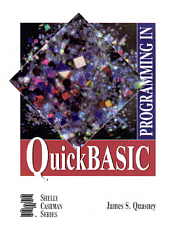
[Bild vergrößern] |
Von James S. Quasney
boyd & fraser publishing company, Boston, 1992, 126 Seiten, 18.75 US $; ca. 20.- EUR ISBN 0-87835-777-7 Kommentar von Thomas Antoni Dieses recht gut geschriebene Lehrbuch führt den absoluten Anfänger in die Grundlagen von QuickBASIC ein. Dabei legt der Autor den Schwerpunkt auf Büroanwendungen und auf einen systematischen Programm- Entwurf. Multimedia- Aspekte wie Grafik und Sound werden nicht behandelt. Es fehlen auch fortgeschrittene Themen wie RANDOM- Dateien, anwenderdefinierte Felder (TYPE..END TYPE) und die Erstellung von EXE-Dateien. Das ist bei einem Einsteigerbuch zu verschmerzen. Weniger verzeihlich ist, dass nur die "alten" lokalen GOSUB- Subroutinen, nicht aber die viel fortschrittlicheren echten SUBs und FUNCTIONs erwähnt werden. Das Buch behandelt nur den QBasic-Sprachumfang. Die erweiterten QuickBASIC- Funktionen bleiben ausgeklammert. Review by Thomas Antoni This clearly written textbook introduces absolute newcomers to the basics of QuickBASIC. The author has a focus on office applications and on a systematical program design. Multimedia, sound and graphics programming are not covered. Advanced subjects like random files, user-defined arrays (TYPEs) and the generation of EXE files are missing as well. This is excusable with a beginner's book. However, unexcusable is dealing with the old-fashioned local GOSUBs and FN functions but not with the state-of-the-art "real" SUBs and FUNCTIONs. The book only covers the QBasic language scope but not the extended QuickBASIC functions. Review by a reader: This book is great, the book allows a person with little or now experience in programming to get a feel for the language and learn how to program correctly... Bewertung / Rating: + |
| The New BASICS - Programming Techniques and Library Development | |
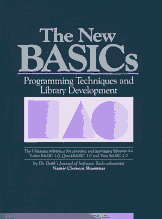
[Bild vergrößern] |
"The Ultimate reference for creating and managing libraries for
Turbo BASIC 1.0, QuickBASIC 3.0 and True BASIC 2.0"
von Namir Clement Shammas M&T Publishing, Redwood City, California, 1987, 417 Seiten, 24.95 US $; ca. 20.- EUR ISBN 0-934375-37-2 (Buch) ISBN 0-934375-43-7 (Buch und Diskette) ISBN 0-934375-44-5 (Diskette) Die Diskette zum Buch enthält sämtliche Quellspracheprogramme und war für 25.- US$ getrennt lieferbar. Kommentar von Thomas Antoni: In diesem Profi-Buch behandelt Namir C. Shammas die drei BASIC-Dialekte QuickBASIC 3.0, Turbo BASIC 1.0 und True BASIC 2.0 für DOS. Borland Turbo BASIC war bekanntlich der Vorgänger von PowerBASIC, so dass auch PowerBASIC-Programmierer von dem Buch durchaus profitieren können. QuickBASIC 3.0 ist aufwärtskompatibel zu QuickBASIC 4.5/7.1 und zu QBasic. Das macht das Buch für die Anhänger dieser Programmiersprachen hochinteressant. True BASIC ist ebenfalls eine moderne und leistungsfähige BASIC-Variante, die ab 1983 von den Ur-BASIC-Erfindern Kemeny und Kurtz entwickelt wurde. True BASIC für DOS ist heute wohl nur noch von historischem Interesse. True BASIC für DOS ist übrigens für ca. 19 US$ bei www.truebasic.com erhältlich. Dort gibt es auch eine Windows-Version für ca. 39.- US$. Das Buch gliedert sich in die folgenden drei Teile
The book is divided in the following three parts:
Bewertung / Rating: ++ |
| Microsoft QuickBASIC for Scientists | |
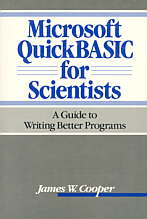
[Bild vergrößern] |
"A Guide to Writing Better Programs"
von James William Cooper John Wiley & Sons, New York, 1988, Softcover, 281 Seiten; 29.95 US$ ISBN 0-471-61301-0 Kommentar von Thomas Antoni: Dieses Buch wendet sich an Programmierer, die bereits etwas Erfahrung mit einem BASIC-Dialekt haben. Es erläutert schwerpunktmäßig fortgeschrittene Programmieraspekte wie
Synopsis by the Publisher: QuickBASIC is a structured language - looping constructs make it powerful for serious programming. This book describes the use of microsoft QuickBASIC for writing better programs for the IBM-PC and compatibles. It also shows how to program in modern fashion without reference to preconceptions of original BASIC. The book is written for the technical user, especially physical scientists, engineers and students who use mathematical operations in their programs. Examples are laid out in block- structured fashion with indentation and comments. In addition, the author treats graphs in Basic on the IBM-PC and on the PS/2; covers EGA and VGA monitors and how to program for them; illustrates the use of sophisticated debugging facilities found in QuickBASIC with problems and solutions; provides overview of assembly language for the 8086 series of microprocessors; and illustrates how simple assembly language routines can be interfaced to QuickBASIC programs. Bewertung / Rating: ++ |
| QuickBASIC Programming for Scientists and Engineers | |
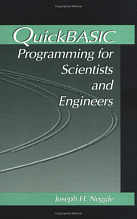
[Bild vergrößern] |
Von Joseph H. Noggle
Verlag CRC Press Inc, 1992, 400 Seiten mit Begleitdiskette, die alle Beispielprogramme enthält. ISBN 0-8493-4434-4 Kommentar von Thomas Antoni: Dieses Buch hätte ich gern, es ist mir aber viel zu teuer ;-( Bei Amazon kostet es gebraucht momentan fast 75,- EUR (Stand 28.11.07). So konnte ich das Buch bisher leider noch nicht lesen. Der Autor ist Chemiker und hat viele Fachbücher über Themen aus der Chemie geschrieben. Das Buch gibt eine umfassende Einführung in QuickBASIC und behandelt zahlreiche Themen aus der höheren Mathematik und der Chemie wie etwa
The book covers the basics and then proceeds to more sophisticated programs using a disk enclosed with the book, containing pre-tested procedures for important operations such as graphing (screen printer, plotters); data entry/edit/save/retrieve; file management; linear regression; cubic spline interpolation; Romberg integration; differential equations; and Fourier transform. These routines give many of the advantages of a spreadsheet, but with a simpler and more powerful programming language. This book shows the reader what these routines do and how to use them effectively. The accompanying disk runs on any IBM or compatible microcomputer with a graphics board, 640K RAM, DOS 3.0 or higher, and a copy of Microsoft QuickBASIC (version 4.0 or higher). |
| Numerical Recipes, Routines and Examples in Basic | |
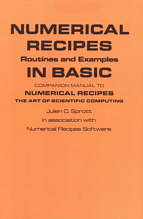
[Bild vergrößern] |
"Companion Manual to
Numerical Recipes: The Art of Scientific Computing"
von Julien C. Sprott (in association with Numerical Recipes Software) Cambridge University Press, erste Auflage, Juni 1991, Taschenbuch, 410 Seiten, 60.00 US$ ISBN 0-521-40689-7 Eine 5,25"-Begleitdiskette oder wahlweise eine CD-ROM, die alle im Buch besprochenen Programme enthält, ist vom Verlag separat lieferbar Kommentar von Thomas Antoni: Dieses sehr gefragte Buch hätte ich gern. Es ist mir aber zu teuer; gebraucht kostet es bei Amazon momentan ca. EUR 38,- (Stand 1.12.2007). Für dieses Buch hat der Autor diverse Algorithmen aus der beliebten Buchreihe "Numerical Recipes" von C/C++ bzw. FORTRAN nach QuickBASIC 4.5 portiert und deren Kommentare entsprechend aufbereitet. Das Buch enthält ein "Schatzkästlein" mit der gewaltigen Anzahl von über 350 sauber kommentierten QuickBASIC-Programmen, in denen fast 200 Algorithmen aus den Gebieten Numerische Analysis und wissenschaftliche Datenverarbeitung programmtechnisch umgesetzt sind. Unter anderem werden folgende Themenbereiche behandelt:
Synopsis by the publisher: This book contains the routines and demonstration programs from the first edition of the highly acclaimed reference book, Numerical Recipes: The Art of Scientific Computing. It includes computer code and code captions from the book and example book and the commentary from the example book. The author employs a contemporary version of BASIC, Microsoft QuickBasic 4.5, which roughly follows the structure of FORTRAN; in fact, the recipes found in this book are easily adapted for other modern forms of BASIC. This book is recommended for use with one of the main Numerical Recipes books, such as Numerical Recipes in Fortran 77. The programs contained in this book are also available as machine- readable code on the Numerical Recipes Code CD-ROM with Windows/Macintosh Single Screen License. Text from the book's back cover: Modern BASIC programmers will be delighted to learn that the routines and demonstration programs from the highly acclaimed reference book Numerical Recipes: The Art of Scientific Computing are now available in their language of choice. Numerical Recipes, by William H. Press, Brian P. Flannery, Saul A. Teukolsky and William T. Vetterling, is a complete handbook containing nearly 200 algorithms or "recipes" for scientific computing and numerical analysis. It is accompanied by the Numerical Recipes Example Book containing programs that demonstrate the subroutines. Julien C. Sprott has translated all of the recipes and programs, over 350 in all, into BASIC. This book brings the routines and programs together in a single source that includes computer code and code captions from both the book and example book and the commentary from the example book. It is recommended for use with one of the main Numerical Recipes books. The author employs Microsoft QuickBasic 4.5, but the recipes are easily adapted to other modern forms of BASIC. The programs contained in this book are also available as machine-readable code on a 5.1/4 inch floppy diskette for IBM compatible computers. Please see inside for information about software and how to order additional Numerical Recipes products. |
Englische Q(uick)Basic-Befehlsrefenzen | |
| Quick Reference Guide QuickBASIC & QBasic | |
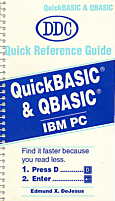
[Bild vergrößern] |
Von Edmund X. DeJesus
Dictation Disc Company, 1992, 235 Seiten, Spiralheftung; 8,95 US $ ISBN 1-56243-089-0 Kommentar von Thomas Antoni: Dieses schmale, handliche Referenzbüchlein enthält eine komplette Sprachreferenz für QuickBASIC 4.5 und QBasic 1.1. Es gliedert sich in folgende 3 Teile:
|
Englische BASIC-Bücher | |
| Inside BASIC Games | |
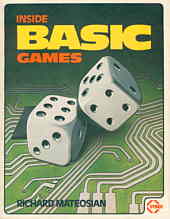
[Bild vergrößern] |
Von Richard Mateosian
SYBEX Inc., 1981, 325 Seiten; 14.99 US $ Diskette für APPLE II und Compact-Cassetten für Commodore PET und TRS-80 sind getrennt lieferbar. ISBN 0-89688-055-0 Kommentar von Thomas Antoni: Dieses Buch zeigt dem Leser, wie er textbasierte Spiele für die Homecomputer Commodore PET, TRS-80 und Apple II in BASIC programmiert. Der Leser sollte ein paar Vorkenntnisse in BASIC oder einer anderen Programmiersprache mitbringen. Richard Mateosian leitet Schritt für Schritt Spielprogramme aus 8 verschiedenen Bereichen ab, z.B. Mathetrainer, Ratespiele (z.B. Hangman und Taxman-Zahlenraten), Partner-Suchspiele, Würfelspiele und "Alien Life", das mit "Game of Life" verwandt ist. Der Autor vermittelt mit seinen Spielprogrammen eine kurzweilige Einführung in alle wichtigen Aspekte der BASIC-Programmierung und in das systematische Vorgehen bei der Programmentwicklung - auch bei komplexeren Softwareprojekten. Zum Entwurf der Programmstruktur wird der Pseudocode "Free BASIC" verwendet, der keine GOTOs und keine Zeilennummern enthält und sich problemlos in alle BASIC- Dialekte, besonders auch in Q(uick)Basic umsetzen lässt. Review by Thomas Antoni: This book instructs the reader how to write text-based games in BASIC running on the Commodore PET, TRS-80 und Apple II home computers. The reader should have some basic knowledge of BASIC or any other programming language. Richard Mateosian demonstrates the development of games from 8 different genres, e.g. math trainers, quizes (e.g. Hangman and a Taxman-type number quiz), partner- searching games, dime games and "Alien Life" which is similar to "Game of Life". The author uses a step-by-step style. The reader enjoys a vivid introduction into all important aspects of BASIC and learns a systematical approach of software design - even with more complex projects. A so called "Free BASIC" pseudocode is used for implementing the program layout. This pseudo code doesn't require line numbers and can easily ported to all BASIC derivatives including Q(uick)Basic Synopsis by the Publisher: Discusses the principles of the BASIC computer programming language and explains how to program computers in BASIC to play a variety of games. Bewertung / Rating: ++ |
|
| |
| [zur Startseite www.antonis.de] [zur framelosen Startseite] |